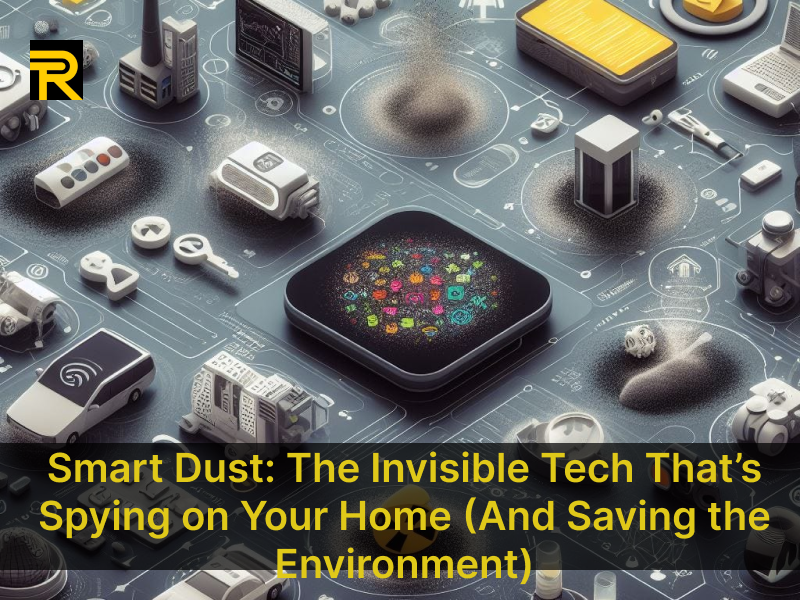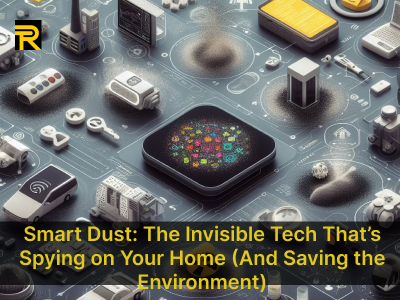
Smart Dust: The Invisible Tech That’s Spying on Your Home (And Saving the Environment)
Smart Dust: The Invisible Tech That’s Spying on Your Home (And Saving the Environment)
Smart dust—tiny, invisible microelectromechanical sensors (MEMS) that can detect light, temperature, chemicals, and even movement—sounds like something out of a sci-fi thriller. But in 2024, smart dust is no longer fiction; it’s everywhere, silently revolutionizing industries, saving the environment, and raising serious concerns about surveillance.
Military-Grade Smart Dust Sensors Exposed
Recent revelations have military-grade smart dust sensors exposed through leaked documents and whistleblower accounts. These ultra-miniaturized devices, developed for battlefield tracking and intelligence gathering, are now suspected to be operating domestically. While the Pentagon initially funded the concept for defense purposes, smart dust's application has expanded into civilian infrastructure, city-wide monitoring, and even covert home surveillance.
The idea that these military-grade smart dust sensors could be floating inside homes, gathering data without permission, is sparking global debate. Activists and technologists alike are urging governments to regulate and disclose where and how these sensors are deployed.
DIY Air Quality Monitors with Arduino
On the bright side, the maker community has embraced this nano-revolution. DIY air quality monitors with Arduino allow individuals to create their own environmental monitoring systems, leveraging the same smart dust tech in a more ethical and transparent way.
These DIY kits can measure pollutants, humidity, and particulate matter in real-time, helping you stay safe and informed—without violating anyone’s privacy. Enthusiasts are even repurposing smart dust motes for open-source air quality logging, proving that tech can be both powerful and responsible.
Privacy Risks of Nanoparticle Tracking
Despite the environmental promise, privacy risks of nanoparticle tracking continue to grow. Since smart dust particles are nearly invisible and can wirelessly transmit data, they are perfect for undetected surveillance.
Once inhaled or embedded on clothing, smart dust can track movements, record conversations, and monitor behavior. In cities outfitted with smart infrastructure, this level of ubiquitous nanoparticle tracking poses a challenge to traditional privacy laws. Regulatory bodies still lag behind in creating effective safeguards for such pervasive tech.
Smart Dust for Wildfire Prevention 2024
Ironically, the same technology raising privacy alarms is also playing a vital role in saving forests and homes. Smart dust for wildfire prevention 2024 is a growing application area where networks of dust-sized sensors are deployed across fire-prone regions.
These sensors detect temperature spikes, smoke, and shifts in wind speed, sending real-time data to emergency teams. In California, early pilot programs using smart dust helped predict and prevent several major wildfires in early 2024. As climate disasters escalate, smart dust may be our strongest invisible ally.
Block Undetectable Surveillance Particles
So, how can you protect yourself? Researchers and hardware hackers are exploring ways to block undetectable surveillance particles. Techniques include electromagnetic jamming, Faraday enclosures, and using anti-static materials to reduce the chances of particles sticking to surfaces.
Still, because smart dust can operate autonomously and wirelessly, blocking it isn’t easy. Detecting or neutralizing these tiny sensors requires specialized equipment, which leads us to the next section.
Environmental Monitoring Startups Using Motes
Despite the controversy, environmental monitoring startups using motes (short for "remote sensor nodes") are growing in number. These companies develop smart dust-enabled systems for monitoring water quality, soil health, and atmospheric pollution.
In 2024, startups in Europe and Asia are pioneering smart dust deployment for precision agriculture, reducing water waste and improving crop yields. By placing motes across fields, farmers receive hyper-local insights that were previously impossible with satellite or drone technology.
Ethical Guidelines for Distributed Sensors
With power comes responsibility. The widespread deployment of smart dust demands ethical guidelines for distributed sensors. Who owns the data? How long is it stored? Can these sensors be disabled?
Non-profits and think tanks are pushing for transparent standards. Some call for a digital “Bill of Rights” for citizens, while others argue for physical visibility requirements—like dye markers or audible signals—on all distributed sensor networks.
These ethical guidelines aim to balance innovation with consent, preventing misuse while encouraging responsible adoption.
How to Detect Smart Dust in Your Home
Wondering how to detect smart dust in your home? You're not alone. With surveillance concerns growing, individuals are seeking ways to identify or neutralize these microscopic spies.
Tech enthusiasts have proposed using UV light to locate certain sensor coatings or building RF frequency scanners to pick up transmission signals. While these methods aren’t foolproof, they're a starting point. As awareness grows, consumer-grade smart dust detectors may soon become as common as smoke alarms.
DARPA’s Smart Dust Research Leaks
In early 2024, a cybersecurity collective leaked documents from DARPA, revealing classified smart dust experiments. The DARPA’s smart dust research leaks detailed programs involving swarm coordination, biometric tracking, and remote behavior prediction.
Though DARPA defends the research as experimental, public backlash has been strong. Activists warn that unless regulated, this tech could easily be repurposed for authoritarian control and invisible mass surveillance.
TikTok’s Viral “Spy Dust” Conspiracy Deep Dive
Adding fuel to the fire, TikTok’s viral “spy dust” conspiracy deep dive gained over 50 million views in just weeks. Videos claim that ordinary products—like laundry detergent and printer paper—may contain embedded smart dust.
While most claims are unproven, they tap into legitimate concerns about transparency, consent, and tech regulation. The viral trend forced several tech companies to release public statements denying the integration of surveillance particles into consumer products.
The TikTok spy dust conspiracy may be extreme, but it’s grounded in real fears—ones supported by recent leaks and research.
Conclusion: Tech's Double-Edged Dust
Smart dust is one of the most transformative—and controversial—technologies of our time. On one hand, it promises to prevent disasters, improve healthcare, and protect the planet. On the other, it threatens to redefine privacy and autonomy as we know them.
From military-grade smart dust sensors exposed to the rise of DIY air quality monitors with Arduino, from privacy risks of nanoparticle tracking to smart dust for wildfire prevention 2024, this invisible tech is reshaping our world—quietly, invisibly, and rapidly.
As users, creators, and regulators, we must stay informed. Whether you’re trying to block undetectable surveillance particles, exploring environmental monitoring startups using motes, or questioning DARPA’s smart dust research leaks, remember: the future is already here, and it’s floating all around you.
Follow Us
Trending News
Newsletter
Join us to get latest News Updates



